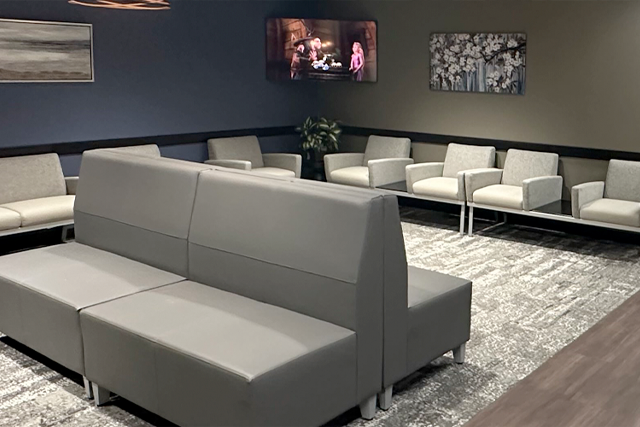Our Blog
Can Advanced Imaging Help Detect Hidden Causes of Chronic Back Pain?

Chronic back pain is a common condition affecting millions of people worldwide, and it can be caused by various underlying issues. For many patients, pinpointing the exact cause of persistent back pain can be challenging, especially when traditional diagnostic methods fall short. Advanced imaging techniques, however, can provide deeper insights into the causes of chronic back pain, helping physicians develop targeted treatment plans. At Great Lakes Medical Imaging (GLMI) in Buffalo, NY, we offer state-of-the-art imaging technologies that aid in detecting hidden causes of chronic back pain. Here’s how advanced imaging can help.
What Causes Chronic Back Pain?
Common Causes of Back Pain
Chronic back pain can arise from several sources, ranging from musculoskeletal issues to nerve-related conditions. Some of the most common causes include:
- Herniated Discs: When the soft material inside a spinal disc pushes out through a crack in the tough exterior, it can irritate nearby nerves, leading to pain and discomfort.
- Spinal Stenosis: A narrowing of the spaces within the spine can put pressure on the nerves, causing chronic pain, numbness, and weakness.
- Degenerative Disc Disease: Over time, spinal discs can wear down, leading to pain, especially when moving or bending.
- Arthritis: Osteoarthritis in the spine can cause inflammation and joint damage, leading to pain.
- Sciatica: This condition occurs when the sciatic nerve, which runs from the lower back down each leg, becomes compressed or irritated.
While these conditions are relatively common, diagnosing the exact cause of back pain can sometimes be difficult. That’s where advanced imaging comes in.
How Advanced Imaging Can Help
MRI (Magnetic Resonance Imaging)
Visualizing Soft Tissue and Nerve Structures
MRI is one of the most powerful tools for diagnosing chronic back pain, especially when the pain is caused by issues related to the spine’s soft tissues. Unlike X-rays, which are primarily used to view bones, MRIs provide detailed images of muscles, ligaments, discs, and nerves. This makes MRI ideal for diagnosing:
- Herniated Discs: MRI can clearly show if a disc is pressing against a nerve, causing pain.
- Spinal Stenosis: The detailed cross-sectional images produced by MRI can reveal any narrowing of the spinal canal.
- Nerve Compression: MRI can identify conditions like sciatica, where nerves are compressed by nearby structures.
In Buffalo, NY, GLMI offers advanced MRI technology that provides high-resolution images, allowing your doctor to assess your spine in detail and identify any abnormalities that may be contributing to your chronic pain.
CT Scans (Computed Tomography)
Detailed Cross-Sectional Images of the Spine
CT scans use X-rays to create detailed cross-sectional images of the body. They are particularly useful for diagnosing conditions affecting the bones of the spine. CT scans can help:
- Detect Spinal Fractures: CT scans can clearly show fractures, especially in patients who may have sustained trauma or who have osteoporosis.
- Identify Degenerative Changes: For patients with degenerative disc disease or arthritis, CT scans can reveal changes in the spine’s structure that may be contributing to pain.
At GLMI, our advanced CT technology allows for detailed imaging that helps doctors better understand the structural causes of back pain.
X-Rays
Identifying Bone Abnormalities
X-rays remain a useful tool for diagnosing certain causes of chronic back pain, particularly when it comes to assessing bone structure. They can help identify:
- Spinal Misalignment: X-rays can reveal abnormal curvature of the spine, such as scoliosis.
- Fractures or Bone Spurs: These bony growths can press on nerves and cause pain.
While X-rays are less detailed than MRI or CT scans, they are often the first step in diagnosing back pain.
Ultrasound
Assessing Muscles and Soft Tissues
While ultrasound is not as commonly used for diagnosing back pain, it can be helpful in assessing the soft tissues of the lower back, including muscles and tendons. Ultrasound may be used to guide injections or other treatments and can help assess issues like muscle strains or ligament injuries.
When Should You Seek Advanced Imaging for Back Pain?
Persistent or Worsening Pain
If you’ve been experiencing chronic back pain for several weeks or months, and conservative treatments like physical therapy or medications aren’t providing relief, it may be time to consider advanced imaging. Imaging can help identify hidden causes of pain that might not be detectable through a physical exam alone.
Neurological Symptoms
If you’re experiencing symptoms like numbness, tingling, or weakness in your legs or arms, advanced imaging may be necessary to determine if nerve compression or damage is causing these symptoms. These neurological issues can often be caused by herniated discs or spinal stenosis, both of which can be detected through MRI or CT scans.
Recent Trauma
If your back pain began after a fall, car accident, or other trauma, advanced imaging may be needed to assess for fractures, disc damage, or other structural issues. Immediate imaging can help guide treatment and prevent further injury.
Why Choose GLMI for Advanced Imaging in Buffalo, NY?
State-of-the-Art Imaging Technology
At Great Lakes Medical Imaging, we offer the latest in diagnostic imaging technology, including high-resolution MRI, CT scans, and X-rays. Our advanced equipment provides clear, accurate images, ensuring that your doctor has the information needed to diagnose and treat your chronic back pain effectively.
Experienced Radiologists
Our board-certified radiologists are experts in interpreting imaging studies related to the spine and musculoskeletal system. Their expertise ensures that any abnormalities contributing to your back pain are identified and reported to your physician, so you can receive the appropriate treatment.
Convenient Locations in Buffalo and Western NY
We understand that chronic pain can make traveling difficult, which is why GLMI has multiple convenient locations across Buffalo, NY, and Western NY. This makes it easy for you to access the imaging services you need close to home.
Take Action Today
Schedule Your Imaging Appointment
If you’re struggling with chronic back pain, advanced imaging may help uncover the underlying cause. Don’t wait to take control of your health—contact us today to schedule your imaging appointment at Great Lakes Medical Imaging. Our team is here to provide the highest quality care and support for all your medical imaging needs.
Consult with Your Healthcare Provider
If you’re unsure whether you need advanced imaging, consult with your healthcare provider. They can help determine if an MRI, CT scan, or X-ray is appropriate based on your symptoms and medical history. Early diagnosis and targeted treatment can help relieve chronic pain and improve your quality of life.
Contact Us for Comprehensive Imaging Services
At Great Lakes Medical Imaging, we are dedicated to providing advanced imaging services to help diagnose and treat chronic back pain in Buffalo, NY, and Western NY. Our technology, expertise, and compassionate care ensure that you receive the best possible diagnostic support. If you have any questions or need to schedule an appointment, please contact us today.
Medical Disclaimer
This article is for general informational purposes only and is not a substitute for professional medical advice. Always consult with a qualified healthcare provider regarding any medical conditions or concerns you may have.
‹ Back









